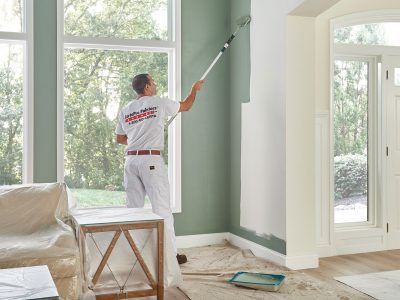Interior House Painting in Midland Texas
We provide professional interior painting, done right the first time. Our team of experienced painters will have your interior looking amazing fast and at a fair price.

Interior House Painting Midland, TX
Whether you are painting the walls yourself or hiring a professional painter, the process involves several steps. Outlining your work will help you anticipate problems, buy supplies, and act as a reference during the project. Although you don't have to plan out every detail of your project, having a checklist is helpful for you to know exactly where to start and where to go next. After all, you do not want to miss a single step!
Cost of interior house painting
While it can be a fun project, interior house painting can also be costly. While some homeowners enjoy the task, others don't have the time or the desire to do it themselves. To help you plan your budget, we've compiled a list of the factors determining interior house painting costs. Before you begin your project, get an estimate of internal house painting costs. This will help you decide when hiring a contractor to do the job.
First, let's talk about labor costs. Labor costs are a significant part of the total cost of interior house painting. For example, professional contractors typically charge $3 to $9 per square foot for painting a single room. In comparison, you can expect to pay between $375 and $6,500 for the entire interior of a four-bedroom house. But there are ways to save money, too. For example, you can choose to hire a less experienced painter or do the project yourself.
Second, consider the size of the job. Larger projects are more efficient because they require fewer materials and labor. However, smaller projects can be challenging to access, requiring more time and more materials. Also, bear in mind that the amount of time spent painting a small room compared to a larger one can vary greatly. Also, remember that time and the type of paint will affect the final cost. Make sure you stay within your budget and finish the job promptly.
Third, determine the amount of paint you need. How much paint is required for a single room? That depends on the square footage of the room and the type of paint. For example, if you plan to paint the walls, you'll need two coats of paint. A guide for estimating the cost of primer paint will give you an idea of what you need. To calculate the amount of color you'll need, measure the width and height of each wall and multiply by 2.
Paint your walls with the right color. Hire an interior decorator to help you choose the paint color. Interior decorators can charge anywhere from $50 to $200 per hour. They will remove cabinets and other hardware before painting and sand and patch any holes or imperfections. To avoid damage, choose neutral colors. Remember to check the painters' insurance and references. In this way, you can rest assured that your new paint job will be beautiful.
Cost of hiring a professional painter
When it comes to the cost of hiring a professional interior house painter, there are many variables to consider. Typical projects can cost anywhere from $900 to $3000, depending on the number of bedrooms and the color and sheen you want to use. In addition, a professional painter will likely charge a higher price if your home is on multiple levels, so be sure to consider this when estimating the cost of a painting job.
The cost of paint can vary significantly by region. Also, the labor fees charged by a contractor will be affected by the wage levels in your area. If you plan to hire a professional painter for your home improvement project, it's wise to ask them how much they charge per square foot and the number of coats of paint required. The cheaper the work, the less color they'll use, and you'll pay for multiple trips to redo the project.
In addition to paint, you'll need to purchase paint supplies, such as brushes and primer. A gallon of paint will cover 432-788-3499 square feet and typically requires two coats. A gallon of paint varies, but the average gallon of paint costs around $60. Primer, generally available at home improvement stores for less than $15 per gallon, will cost about $30.
The price of a professional interior house painter depends on some factors. Choosing an insured and licensed painter will affect the project's total cost. In addition to experience, quality and brand of paint will also impact the final price. A good contractor will charge you a fair fee and ensure you'll be satisfied with the results. So, whether you're looking for a home painter for a new or existing job, a good painting company is worth the price.
Interior house painting costs are based on various factors, including the size of the home. Generally, the more surface area the room has, the higher the labor and materials cost. A typical project will cost between $1 and $4 per square foot. Bathrooms tend to be relatively cheap to paint because shower and tub areas are typically tiled or acrylic. A small half-bath or main bathroom can cost as little as $50 to $150.
Preparing your walls for painting
Preparing your walls for interior house painting can be done yourself by removing dust, dirt, and grease. This will ensure that the paint will be applied smoothly. Next, remove any loose wallpaper and other damage from the walls to avoid bumps in color. Next, you can use fine-grit sandpaper to smooth out the transition. If necessary, use a chemical cleaner on your walls. Once these steps have been completed, allow the walls to dry completely.
Cleaning the walls: After you have cleaned the walls, you can apply painter's tape, brush or roll primer on them, and caulk any cracks or holes. It is recommended that you prepare your walls several days ahead of time so that they can dry before the painting contractor arrives. Make sure that you read the instructions carefully and follow the guidelines for the letter. It's best to hire a professional interior painter if you have a limited budget.
Repairing walls is another essential step in interior house painting. Before starting the painting process, check the walls carefully for any flaws or damaged areas. Cracks and loose patches of old plaster are widespread. Also, check for nail marks and gaps around window and door frames. If there are any, patch them up with a flexible sealant or use a patch of fresh plaster. You'll also want to take advantage of the utility light to help find flaws.
Before you begin the actual painting process, you should remove any wall hangings. This will reduce the work of the painting crew. It's best to remove them a week or two before the paint crew arrives. It will also be easier for you to paint. In addition to removing the wall hangings, you should also remove any soft furnishings such as carpets and rugs. This will ensure that the walls are spotless and ready to receive the paint.
Make sure you have a tape ready. Using painter's tape is an excellent invention! The level of video you need will depend on your experience with a brush. Beginners should tape the edges of ceilings and baseboards. More experienced painters should tape trim and baseboards as well. Then, if necessary, use a putty knife to push the tape edge up against the wall. Drop cloths are also a good idea for baseboards.
Choosing the right paint colors
When choosing the right paint colors for interior house painting, there are many factors to consider. First, you should view the color properties of different colors and the undertones. If you haven't already done so, get a paint sample to see how the paint will look in other areas of your home. Undertones are hidden colors that appear beneath the surface of the paint color. They can be pretty noticeable, so choosing the right paint color based on its undertones is essential.
Choosing the right paint color is essential for the interior house painting project. The right choice will lift your mood and set the scene. Interior painting colors form the backdrop of all interiors. Therefore, it's best to research the various options and narrow them down to a few. It's also helpful to test paint samples to determine which color best matches your room. If you're not sure what to choose, you can ask a professional to help you choose a paint color.
Always remember to test a few paint swatches in the room before painting the entire room. It's important to test colors against your furnishings and fabrics to see which one matches the others. Make sure you check the undertones of your furniture and fabrics before choosing the paint color. Also, consider the sheen of the paint. A high gloss will highlight flaws, while a low luster will mask them.
Choosing the right paint colors for interior house paintings is a daunting task, and you may be unsure of what color to choose. However, choosing colors that flow well with each room is essential, and the transition from interior to exterior is smooth. Try using the color tools offered by Sherwin Williams, including the ColorSnap tool. The color tool will give you an idea of how the paint color will look in your room.
Most homeowners aim to match the color of their walls to the color of the furniture and another decor in the room. But, many of us aren't so lucky. While selecting paint colors is not an exact science, a little inspiration will go a long way. Take inspiration from a favorite object. Chances are, it contains pigments that match your home's decor. You can also try a color sample to check out if it fits.
